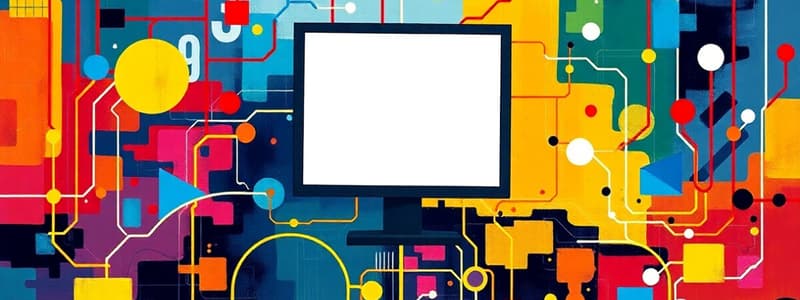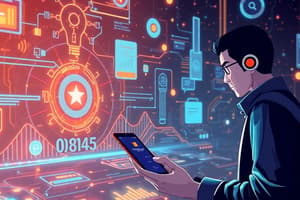Podcast
Questions and Answers
What is mass customization?
What is mass customization?
- Offering products in bulk at lower prices
- Creating standard products for a wide audience
- Providing a one-size-fits-all solution to consumers
- Adapting products or services to meet individual customer specifications (correct)
Which term describes the situation when a company directly sells its products instead of going through intermediaries?
Which term describes the situation when a company directly sells its products instead of going through intermediaries?
- Disintermediation (correct)
- Intermediation
- Reintermediation
- Cybermediation
What does interactivity measure in advertising effectiveness?
What does interactivity measure in advertising effectiveness?
- The cost efficiency of advertising campaigns
- Visitor interactions with the advertisement, like views and repeat visits (correct)
- The demographic data of visitors to the ads
- The overall sales generated through advertisements
What does clickstream data track?
What does clickstream data track?
What is personalization in a business context?
What is personalization in a business context?
What is the primary function of an affiliate program in the context of online marketing?
What is the primary function of an affiliate program in the context of online marketing?
Which type of online advertisement appears as a small window on the screen without interrupting the user's current activity?
Which type of online advertisement appears as a small window on the screen without interrupting the user's current activity?
What does a heat map represent?
What does a heat map represent?
Which of the following best describes the concept of 'The Long Tail'?
Which of the following best describes the concept of 'The Long Tail'?
What defines disruptive technology?
What defines disruptive technology?
How does clickstream analytics contribute to website performance evaluation?
How does clickstream analytics contribute to website performance evaluation?
What is the role of a web browser?
What is the role of a web browser?
What is an intermediary in the context of buying and selling?
What is an intermediary in the context of buying and selling?
What do website traffic analytics primarily assess?
What do website traffic analytics primarily assess?
What is the focus of website ebusiness analytics?
What is the focus of website ebusiness analytics?
Which of the following describes eBusiness?
Which of the following describes eBusiness?
What best defines an ebusiness model?
What best defines an ebusiness model?
What is the primary purpose of the Hypertext Transport Protocol (HTTP)?
What is the primary purpose of the Hypertext Transport Protocol (HTTP)?
What is Web 1.0 known for?
What is Web 1.0 known for?
Which marketing technique encourages users to share a marketing message or content?
Which marketing technique encourages users to share a marketing message or content?
Which aspect is essential for an effective banner ad?
Which aspect is essential for an effective banner ad?
What are the main impacts of the Internet on information?
What are the main impacts of the Internet on information?
What does sustaining technology aim to achieve?
What does sustaining technology aim to achieve?
Which of the following statements best describes the Innovator’s Dilemma?
Which of the following statements best describes the Innovator’s Dilemma?
Which of the following is NOT a common ebusiness form?
Which of the following is NOT a common ebusiness form?
What is the main purpose of search engine optimization?
What is the main purpose of search engine optimization?
Which revenue model allows businesses to earn income based on the number of clicks on an advertisement?
Which revenue model allows businesses to earn income based on the number of clicks on an advertisement?
Which of the following describes click fraud?
Which of the following describes click fraud?
What do hitbots simulate in the context of online advertising?
What do hitbots simulate in the context of online advertising?
Which of the following revenue models is associated with recurring payments for continued access to a service or content?
Which of the following revenue models is associated with recurring payments for continued access to a service or content?
An affiliate program primarily benefits a business by:
An affiliate program primarily benefits a business by:
Which of the following strategies is NOT considered a means of generating revenue in e-business?
Which of the following strategies is NOT considered a means of generating revenue in e-business?
Which of the following is NOT considered a tool for connecting and communicating in eBusiness?
Which of the following is NOT considered a tool for connecting and communicating in eBusiness?
What are the three characteristics that define Web 2.0?
What are the three characteristics that define Web 2.0?
What is a key feature of the Direct-to-Consumer (DTC) eBusiness model?
What is a key feature of the Direct-to-Consumer (DTC) eBusiness model?
Which of the following describes an open system in content sharing?
Which of the following describes an open system in content sharing?
User-contributed content is characterized by which of the following?
User-contributed content is characterized by which of the following?
Which aspect does NOT represent an advantage of Business 2.0?
Which aspect does NOT represent an advantage of Business 2.0?
Which statement best describes open source software?
Which statement best describes open source software?
What role does a reputation system play in user-contributed content?
What role does a reputation system play in user-contributed content?
Study Notes
Ebusiness Overview
- Disruptive Technology: Innovations that initially do not meet existing customer needs but eventually transform markets.
- Sustaining Technology: Improvements made to existing products that customers are eager to buy.
- Innovator’s Dilemma: The challenge for established companies to embrace disruptive technologies without losing current customer relationships.
Internet and World Wide Web
- World Wide Web (WWW): Utilizes HTML to provide access to various types of information on the Internet, including text, graphics, audio, and video.
- Web Browser: Software that enables users to navigate the WWW.
- Hypertext Transport Protocol (HTTP): The protocol used to request and display web pages through URLs.
Web 1.0
- Definition: The early stage of the WWW from 1991 to 2003, focused primarily on information dissemination.
- Ecommerce: The buying and selling of goods and services online.
- Ebusiness: Encompasses ecommerce plus all business operations conducted online.
Global Reach of the Internet
- Impact: The Internet increases the richness, reach, and content quality of information available globally.
Market Expansion
- Mass Customization: Strategy of personalizing products to meet specific customer demands.
- Personalization: Tailoring offers based on a customer's preferences and interests.
Cost Reduction Strategies
- The Long Tail: Describes the sales curve where niche products can collectively make up a significant market share.
- Intermediaries: Entities that facilitate trade between buyers and sellers, involving concepts like disintermediation (direct selling), reintermediation, and cybermediation.
Effectiveness Improvements
- Interactivity: Measures advertising success through visitor engagement metrics such as time spent and pages viewed.
- Heat Map: Visual representation of data where values are displayed through color coding.
- Clickstream Data: Tracks the navigation patterns of users on a website, revealing insights on page visits, durations, and shopping cart behavior.
Revenue Generation and Marketing
- Affiliate Program: Enables businesses to earn commissions when referred customers click on links to other merchants.
- Banner Ads: Graphics placed on web pages for advertising.
- Pop-up Ads: Small windows that appear to display advertisements.
- Viral Marketing: Strategy encouraging users to share marketing messages widely.
Ebusiness Models
- Definition: Frameworks that outline how a company creates, delivers, and captures value online.
- Common B2C Models: Ebusiness methodologies targeting end consumers.
Ebusiness Forms
- Types:
- Content Providers: Supply information or entertainment.
- Infomediaries: Serve as intermediaries that provide data and information services.
- Marketplaces: Platforms for buyers and sellers.
- Portals: Centralized access points (e.g., Google).
- Service Providers: Offer services online.
- Transaction Brokers: Facilitate transactions between buyers and sellers.
Search Engine Dynamics
- Search Engines: Software designed to locate web pages based on keyword relevance.
- Search Engine Ranking: Criteria used to determine URL placement in search results.
- Search Engine Optimization (SEO): Techniques to enhance website visibility and ranking.
Ebusiness Revenue Models
- Types of Revenues:
- Advertising Fees
- License Fees
- Subscription Fees
- Transaction Fees
- Value-added Service Fees (e.g., pay-per-click)
Ebusiness Fraud
- Affiliate Program Fraud: Generates commissions through deceptive clicks leading to no real traffic.
- Click Fraud: Artificially inflating click counts on ads.
- Hitbots: Automated processes that mimic user clicks without real intent.
Communication Tools
- Standard Tools: Email, instant messaging, podcasting, videoconferencing, web conferencing, and content management systems facilitate online communication.
Web 2.0 Characteristics
- Definition: Represents a more interactive and mature phase of the Internet, emphasizing collaboration, sharing, and cost efficiency.
- Direct-to-Consumer (DTC): Business model where companies sell directly to consumers, eliminating intermediaries.
Open Sourcing and User-Generated Content
- Open Systems: Nonproprietary systems that allow third-party developments.
- User-Contributed Content: Content created and maintained by users for communal benefit, incorporating reputation systems and native advertising techniques.
Studying That Suits You
Use AI to generate personalized quizzes and flashcards to suit your learning preferences.
Related Documents
Description
Explore Chapter 3 of Ebusiness, focusing on the concepts of disruptive and sustaining technology. Understand how technologies, from steamboats to modern processors, transform markets and impact value creation. Test your knowledge on these crucial technological distinctions!




